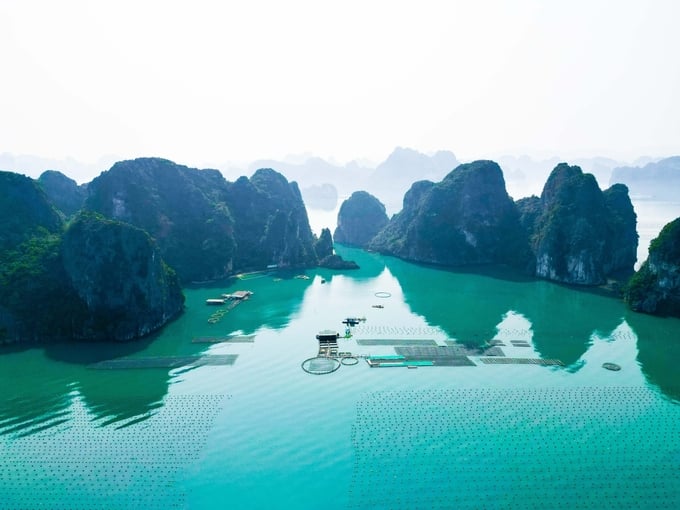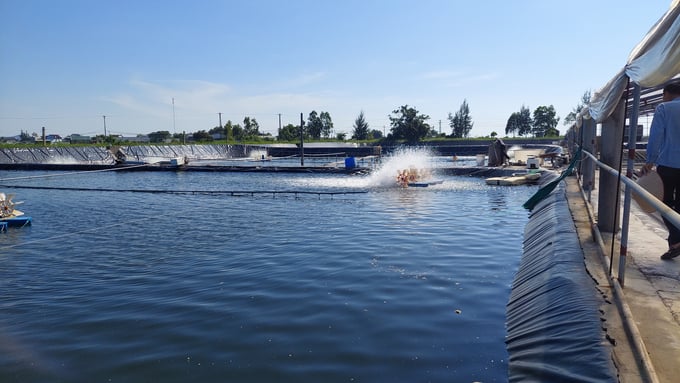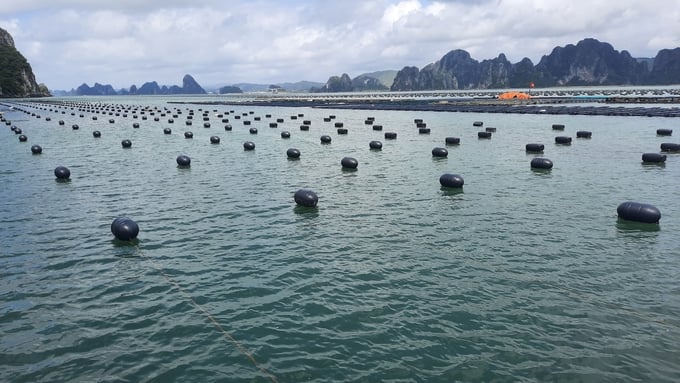May 21, 2025 | 03:17 GMT +7
May 21, 2025 | 03:17 GMT +7
Hotline: 0913.378.918
May 21, 2025 | 03:17 GMT +7
Hotline: 0913.378.918

Quang Ninh province’s current priority is to keep the marine environment clean by using environment-friendly materials. Photo: Van Nguyen.
Identified as a key field in the development of agricultural economy, Mong Cai city has promoted the application of science and technology, environmental protection, and invested in upgrading the infrastructure of concentrated farming areas, aiming toward the development of sustainable aquaculture.
According to Bui Son Truong, Vice Chairman of Van Ninh Commune People's Committee, the commune farms 315 ha of shrimp every year, resulting in an average output of 750 tons of commercial shrimp. The average revenue is VND 75 billion per year, of which the annual profit is VND 30 billion, contributing to raising the income of aquaculture households.
In Hai Hoa ward - the largest shrimp farming area of Mong Cai city, although aquaculture activities here were heavily affected by the Covid-19 epidemic, right after the recovery period, more than 200 farming households in the ward all pay special attention to sustainable shrimp farming practices.
Bui Ngoc Liem in zone 9, Hai Hoa ward, owns one of the large-scale industrial shrimp farming facilities applying advanced technology in Mong Cai. He still recalls the “unforgettable” lesson from the shrimp disease. From his perspective, the cause of diseases in this business mostly stems from environmental factors.
“The family's 6.5 ha shrimp farming infrastructure has been invested more than VND 80 billion up to this point. Our entire shrimp farming area meets the criteria of VietGAP standards. In this crop, my family plans to raise 4 ha of shrimp. However, due to the previous impact of the Covid-19 pandemic, so far, I have only raised more than 50,000 shrimp seeds in an area of more than 2 ha”.

Many shrimp farming households in Mong Cai city have signed environmental protection commitments. Photo: Nguyen Thanh.
Starting this crop, Liem still persists in using BOX microorganisms. This American product has been tested by the provincial Farmer’s Union in a number of shrimp farming facilities for many years. Along with the culture technology using BOX, all the ponds of his facility are applying water circulation technology deployed by the Department of Science and Technology.
Thanks to this technology, the nursery stage only takes 1 month, and the rearing time is only 2 months per crop, helping shrimp farmers raise 3-4 crops/year. With water circulation technology and an environmental monitoring and warning system installed in all ponds, shrimp farmers can control the water environment and disease situation anytime, anywhere, thus reducing the risk of disease in the farming process.
Recently the situation of foam buoys floating is alarming, the collection process lacks proper clearing, thus affecting the beauty and environment of the waters of Quang Ninh province.
Leaders of Quang Ninh province have asked all localities (Ha Long, Cam Pha, Van Don, Quang Yen) to be responsible for collecting garbage in the farming area; strictly control the handling of cages and rafts, replace the foam buoys to prevent the discharge of waste to Ha Long bay and Bai Tu Long bay due to the dismantling of cages and rafts; have a plan to monitor and recover materials and organize collection right from the source when waste is released into the environment.

The functional forces of Van Don district collect foam buoys in Bai Tu Long Bay. Photo: Van Nguyen.
By the end of 2022, there were 971 farming households in Van Don district using approximately 2.7 million foam buoys for aquaculture, accounting for nearly 90% of the number of foam buoys that need to be converted to HDPE in Quang Ninh province. At the end of April 2023, Quang Ninh mobilized the functional forces simultaneously in coastal localities to collect foam buoys, aiming to return the blue color of the sea, clean and beautiful environment to the farming areas, including Van Don.
The communication and campaign to replace foam floats in aquaculture have now received support from the majority of people in the district. Farmers also expressed their wish to stabilize their long-term livelihood.
The issuance of farming area codes and allocation of water surface to marine farming households is similar to granting a "pass" to key seafood of localities. The owner of the farming establishment and the origin of the product can be identified through the code, thereby improving the product value and meeting export requirements. Another thing is that the granting of farming area codes also changes the awareness and actions of people and businesses in improving productivity, farming acreage, product quality and output.

The issuance of farming area codes and allocation of water surface to marine farming households still show certain limitations. Photo: Nguyen Thanh.
Do Dinh Minh, Director of the Quang Ninh Sub-Department of Fisheries, said that the province will soon strengthen the appraisal and grant codes and codes for farming areas and safe processing facilities. The province’s fishery sector also strives to build production linkage models as a foundation for Quang Ninh seafood products to reach difficult but high-value markets.
In order to remove difficulties in the implementation of issuing codes for shrimp farming establishments, Tran Dinh Luan, Director of the Department of Fisheries (Ministry of Agriculture and Rural Development), said: "The mindset is to minimize the conditions so that households can register and be granted a farming area code. It is necessary to perform the tasks in parallel, both to adjust the provisions of the law and urge the local authorities to “step in” with specialized agencies, guiding the district and commune authorities to help farmers complete the registration for farming area code issuance".
Translated by Samuel Pham

(VAN) Japan's grant aid project contributes to capacity building, promoting organic agricultural production, and fostering sustainable community development in Dong Thap province.

(VAN) For years, the CRISPR-Cas9 genome technology has been reshaping genetic engineering, a precision tool to transform everything from agriculture to medicine.

(VAN) Vietnam aims to become a 'leader' in the region in the capacity and managing effectively soil health and crop nutrition.
![Reducing emissions from rice fields: [Part 1] Farming clean rice together](https://t.ex-cdn.com/nongnghiepmoitruong.vn/608w/files/news/2025/05/05/z6509661417740_a647202949c539012a959e841c03e1d3-nongnghiep-143611.jpg)
(VAN) Growing clean rice helps reduce environmental pollution while increasing income, allowing farmers to feel secure in production and remain committed to their fields for the long term.
/2025/05/19/5136-1-144800_230.jpg)
(VAN) The Nghe An Provincial People's Committee has just approved the list of beneficiaries eligible for revenue from the Emission Reductions Payment Agreement (ERPA) in the North Central region for the year 2025.

(VAN) 14 out of 35 domesticated elephants in Dak Lak province have had their living conditions improved, with 11 of them currently participating in the non-riding elephant tourism model.

(VAN) Muong Nhe Nature Reserve hopes that being upgraded to a national park will lay the foundation for forest protection efforts to be carried out in a systematic, modern, and sustainable manner.